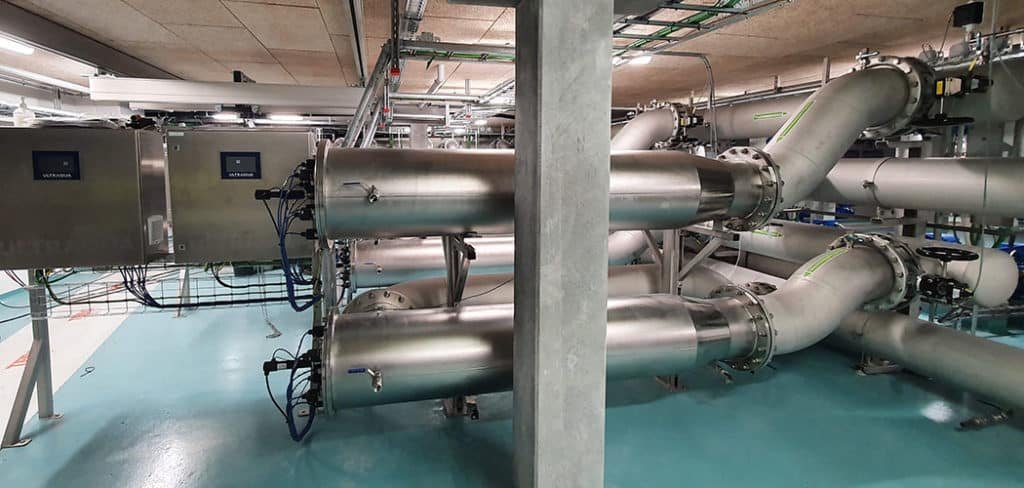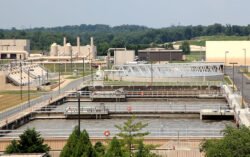
Ultraviolet (UV) Disinfection in Water: Ensuring Safe and Clean Drinking Water

Ultraviolet (UV) disinfection is a powerful method for making drinking water safe. It uses UV light to kill harmful bacteria and viruses in the water. This technology is popular because it doesn’t add chemicals to the water, making it a clean and green option.
UV disinfection systems are used in many places, from large water treatment plants to personal home systems. These systems are especially valuable in emergencies where clean water is not available because they can quickly disinfect clear water. Understanding how these systems work and how to maintain them can help ensure safe and reliable drinking water.
Proper installation and operation are vital for UV disinfection systems to work effectively. Regular maintenance is required to keep the systems running smoothly. It’s important to monitor the components and replace parts as needed to avoid any disruption in water safety.
Key Takeaways
- UV disinfection kills harmful bacteria and viruses without chemicals.
- Systems are used in various settings, from large plants to homes.
- Regular maintenance is essential for effectiveness.
Fundamentals of Ultraviolet Disinfection
Ultraviolet (UV) disinfection is a key method used in water treatment. It inactivates harmful microorganisms by damaging their DNA. This method involves understanding the properties and effects of UV light.
Principles of UV Light
UV light functions by penetrating the cells of bacteria, viruses, and other pathogens. When UV light at a wavelength of around 254 nm is absorbed by the organism, it causes changes to its DNA. This process prevents the microorganisms from reproducing and renders them harmless.
UV light systems work by exposing water to UV lamps in a controlled environment. These lamps emit UV radiation that passes through the water, effectively disinfecting it by targeting the DNA of any present pathogens. This method is widely used in various water treatment facilities due to its efficiency and lack of chemical by-products.
Spectrum of Ultraviolet Light
The UV spectrum is divided into different ranges: UVA, UVB, UVC, and vacuum UV. UVC, with a wavelength range of 200-280 nm, is most effective for water disinfection. UVC light is the kind that is commonly used in water treatment plants. It has the right balance of energy to disrupt the DNA of microorganisms without forming harmful by-products.
UV disinfection systems often utilize ultraviolet light-emitting diodes (UV-LEDs). These are an emerging technology with advantages over traditional mercury lamps, such as longer lifespans and lower power consumption. Additionally, the use of UV radiation at 254 nm typically results in the formation of pyrimidine dimers in the DNA, interrupting essential processes for microorganisms. This makes UV light a powerful tool for ensuring safe drinking water.
UV Disinfection System Components
Ultraviolet (UV) disinfection systems for water treatment rely on several key components to ensure effective disinfection. These include UV lamps, contact chambers, and monitoring systems.
UV Lamps
UV lamps are the core of any UV disinfection system. They produce UV-C light, which is germicidal and can kill or inactivate microorganisms like bacteria, viruses, and protozoa.
These lamps typically contain mercury vapor and operate at a specific wavelength, around 254 nanometers, which is optimal for disinfection. The lamps come in different designs, such as low-pressure, high-output (LPHO), and medium-pressure (MP) lamps, each suited for different applications and flow rates. Regular maintenance and replacement of the lamps are necessary to maintain efficiency, as their intensity decreases over time.
Contact Chambers
Contact chambers are designed to expose water to UV light for a sufficient period. These chambers ensure that the water flow is controlled, allowing maximum exposure to the UV rays emitted by the lamps.
The design of these chambers varies, but they often include features that promote turbulent flow, ensuring even distribution of UV light throughout the water. Properly designed contact chambers maximize the disinfection efficacy by preventing shadows and ensuring all microorganisms receive adequate UV exposure. Materials used for the chambers must be compatible with UV light to avoid degradation and maintain longevity.
Monitoring Systems
Monitoring systems are essential for tracking the performance of the UV disinfection system. These systems often include sensors that measure UV intensity, lamp hours, and water quality parameters.
Real-time data from these monitoring systems helps operators ensure that the system is functioning correctly and that the water is being adequately disinfected. Alarms and automated controls can adjust system operations based on the monitored data, providing a reliable way to maintain water quality. Regular calibration and maintenance of the sensors are crucial for the accuracy and reliability of the monitoring systems.
Installation and Operation
Proper installation and operation are essential to ensure the effectiveness of ultraviolet (UV) disinfection in water treatment. This includes configuring the system correctly and following strict operational guidelines to maintain safety and efficiency.
System Configuration
UV disinfection systems typically use lamps that emit UV light to neutralize pathogens in water. The most common configuration involves low-pressure, low-intensity mercury vapor lamps. These lamps are housed in a reactor vessel where water flows through, exposing microorganisms to UV light, which disrupts their DNA and renders them inactive.
When installing a UV disinfection system, proper placement of the lamps within the reactor is critical. The lamps should be equally spaced to ensure uniform exposure to UV light. The system should also include a UV sensor to monitor the intensity of UV light and ensure it remains at effective levels for disinfection.
Operational Guidelines
Operational guidelines for UV disinfection systems emphasize regular maintenance and monitoring to ensure continuous effectiveness. UV lamps have a limited lifespan and should be replaced according to the manufacturer’s recommendations, typically every 9-12 months.
Water quality affects the efficiency of UV disinfection. Suspended particles and turbidity can shield pathogens from UV light, reducing disinfection efficiency. Pre-treatment processes like filtration may be necessary to remove these particles.
Operators should also perform routine checks on the system’s electrical components and control units. Ensuring that the UV intensity sensor and other monitoring devices are functioning correctly is crucial. Regular cleaning of the quartz sleeves that encase the UV lamps is necessary to prevent fouling, which can block UV light.
For more detailed guidelines, refer to the EPA fact sheet on UV disinfection.
Applications of UV Disinfection
Ultraviolet (UV) disinfection is widely used in various water treatment settings due to its ability to efficiently kill pathogens without chemicals. It is utilized in municipal, industrial, and residential contexts for treating water.
Municipal Water Treatment
Municipalities use UV disinfection to ensure safe drinking water. This method is effective against numerous pathogens, including viruses, bacteria, and cysts. It helps comply with regulations such as the Long Term 2 Enhanced Surface Water Treatment Rule. Municipal treatment plants often integrate UV systems to improve water quality and protect public health.
UV treatment is advantageous as it leaves no chemical residues and doesn’t produce harmful by-products. This makes it a preferred choice over chlorine, which can form carcinogenic compounds. Municipal plants carefully monitor UV doses and maintenance to ensure continuous effectiveness.
Industrial Water Treatment
In industrial settings, UV disinfection is crucial for processes requiring high-purity water. Industries like pharmaceuticals, electronics, and food production rely on UV treatment to eliminate contaminants. Ultraviolet disinfection ensures water used in manufacturing meets stringent quality standards.
UV systems in these industries are designed to handle large volumes of water efficiently. They help maintain product safety and quality by preventing microbial growth. The absence of chemicals in UV treatment also means there is no risk of introducing unwanted substances into the production process.
Residential Water Treatment
At the residential level, UV disinfection provides homeowners with safe drinking water. Home UV systems are compact, easy to install, and effective in killing disease-causing organisms. These systems are particularly beneficial for homes using well water or those in areas with questionable water quality.
Residential UV systems usually work alongside other filtration methods to provide comprehensive purification. They are often chosen for their reliability and low maintenance. By using UV light, homeowners can avoid the taste and odor issues associated with chemical disinfection methods like chlorine.
UV disinfection in these different settings ensures water safety across various use cases, enhancing public health and product quality.
Efficacy and Spectrum of Activity
Ultraviolet (UV) disinfection is a critical process that effectively inactivates various microorganisms in water. Its efficacy is influenced by different parameters, including the spectrum and intensity of the UV light used.
Microorganisms Affected
UV disinfection is particularly effective against a wide array of pathogens. Bacteria such as E. coli and Salmonella are easily inactivated by UV-C light, specifically around 254 nm. This wavelength disrupts the DNA of these microorganisms, preventing replication.
Viruses like SARS-CoV-2 and HCoV-229E are also sensitive to UV-C light. Research shows that even at low doses, UV-C can significantly reduce the viral load in water (source). Protozoa including Giardia and Cryptosporidium are more resilient but still susceptible to higher doses of UV-C.
Fungi and algae in water systems can be effectively controlled using UV light, which targets their cellular structures. This broad spectrum of activity makes UV lights for disinfecting water a versatile and powerful tool in water treatment.
Parameters Affecting Efficacy
Several factors influence the efficacy of UV disinfection. Wavelength is crucial; UV-C light around 254 nm is most effective. Different wavelengths (e.g., 267 nm and 278 nm) show varying levels of efficiency in specific applications (source).
Intensity and exposure time are also important. Higher intensity or longer exposure increases the chances of inactivating microorganisms. Water clarity impacts UV penetration; turbid water reduces effectiveness.
System design matters too. Proper placement of UV lamps and using reflectors can enhance exposure. Systems like the UV disinfection robot can estimate disinfection time automatically, ensuring optimal efficacy (source).
Lastly, the temperature and flow rate of water can affect the performance of UV systems. Cold water may enhance UV effectiveness, while high flow rates can reduce contact time, requiring adjustments in system operation.
Maintenance and Troubleshooting
Ensuring the effective operation of a UV light water filter requires regular maintenance and the ability to address common issues that may arise. Proper care can significantly extend the lifespan of the system and maintain its efficiency.
Routine Maintenance
Routine maintenance is crucial for the longevity and efficiency of UV disinfection systems. Cleaning the quartz sleeve is necessary because, over time, it can become coated with minerals, reducing UV light penetration. The quartz sleeve should be removed and cleaned with a soft cloth and a suitable cleaner.
Changing the UV lamp annually is also important. Even if the lamp still lights up, its UV intensity decreases over time, making it less effective. Checking electrical connections and ensuring they are tight and free from corrosion is another essential step. Proper maintenance helps to minimize downtime and keeps the water safe for use.
Common System Issues
Common issues with UV light water filters include lamp failure, reduced UV output, and alarm activation. Lamp failure is often due to old age, electrical issues, or power surges. Replacing the lamp typically resolves this issue. Reduced UV output can be caused by a dirty quartz sleeve or an aging lamp. Ensuring the sleeve is clean and the lamp is replaced regularly can help maintain optimal performance.
Alarm activation may indicate low UV intensity, which could be due to a failing lamp or dirty sleeve. Regular inspections and timely replacement of components are key steps in troubleshooting. Properly addressing these common issues ensures that the system continues to effectively disinfect water without interruption.
Advantages and Limitations
Ultraviolet (UV) disinfection in water treatment has several important benefits, but there are also certain constraints and considerations to keep in mind.
Benefits of UV Disinfection
UV disinfection is highly effective at eliminating pathogens such as bacteria, viruses, and fungi. It does this without the use of harmful chemicals, making it a cleaner option compared to traditional methods like chlorination.
A significant advantage is the speed of treatment. UV systems can disinfect water almost instantaneously, allowing for continuous treatment without long hold times. Moreover, it does not alter the taste, color, or odor of water, which is particularly important for drinking water applications.
The technology is also relatively simple to operate and maintain, with low ongoing costs after the initial installation. Additionally, UV disinfection systems can be scaled to fit various sizes, from small household units to large municipal facilities.
Constraints and Considerations
There are limitations to using UV disinfection for water treatment. One key concern is that UV light only works well with clear water. Turbidity and suspended solids can block UV rays, reducing the effectiveness of disinfection.
Another important consideration is that UV disinfection does not provide any residual disinfectant. This means there’s no ongoing protection against potential contamination after the water has been treated. Maintenance of the system is crucial, as lamps need regular cleaning and periodic replacement to ensure efficacy.
Initial costs can also be higher compared to some other disinfection methods. Power consumption is another factor, as UV systems require a consistent electricity supply to operate. Finally, unlike some chemical treatments, UV disinfection may not be effective against some spore-forming organisms.
Regulatory and Safety Considerations
When using ultraviolet (UV) disinfection for water treatment, both regulatory compliance and safety precautions are crucial. Ensuring compliance with standards and implementing safety measures helps maintain the effectiveness of the system and protect public health.
Regulatory Compliance
Regulatory compliance for UV disinfection in water treatment involves meeting specific guidelines set by health and environmental agencies. In the United States, the Environmental Protection Agency (EPA) outlines requirements for UV systems to ensure they effectively reduce microbial contaminants. These include proper maintenance, regular monitoring, and validation of UV dose.
National and international standards, such as those from the American Water Works Association (AWWA) and World Health Organization (WHO), further specify performance criteria and operational protocols. These standards often require periodic testing of UV intensity and water quality to maintain certification. Compliance also includes documenting operational parameters and maintaining records for inspection.
Proper installation and operation of UV systems must align with local regulations to ensure that treated water meets safe drinking quality standards. Adhering to these guidelines not only ensures safe water but also helps prevent legal and financial repercussions.
Safety Precautions
Safety precautions are essential when operating UV disinfection systems. Direct exposure to UV light can be harmful to skin and eyes, necessitating the use of protective gear, such as gloves and UV-blocking safety glasses. Operators should be trained in the safe handling and maintenance of UV equipment to avoid accidental exposure.
To ensure safe operation, systems should include interlocking mechanisms that automatically shut off the UV light when the unit is opened for maintenance. Regular inspection and replacement of UV lamps are necessary to maintain optimal performance, as lamp efficiency decreases over time. Shielding and enclosures for UV lamps can further prevent accidental exposure.
Proper signage and warnings around UV disinfection units alert personnel to the hazards. Additionally, ensuring that UV systems are adequately ventilated prevents overheating and maintains system integrity. Safety precautions extend to monitoring water quality post-treatment to confirm effective microbial inactivation and prevent health risks.
Frequently Asked Questions
UV disinfection is a popular method for treating water due to its efficiency in killing harmful organisms. There are certain considerations such as its efficacy, potential risks, limitations, maintenance, and applicability to various water sources.
How effective is UV light in disinfecting water?
UV light is highly effective in killing bacteria, viruses, and fungi in water. It works by using UV-C energy, which disrupts the DNA of these organisms, rendering them inactive and unable to reproduce. UV-C has shorter wavelengths than UV-A and UV-B, allowing it to penetrate and destroy microbial cells.
Are there any potential risks associated with drinking UV-disinfected water?
UV-disinfected water is generally safe to drink since UV treatment does not introduce chemicals or residual byproducts. It only uses light energy to inactivate microorganisms. However, it is crucial to ensure that the water is not recontaminated after treatment, as UV light does not provide residual disinfection like chlorine.
What are the limitations of using UV radiation for water disinfection?
One limitation is that UV light cannot remove chemical pollutants or heavy metals from water. It is only effective against biological contaminants. Additionally, turbid or cloudy water can hinder the penetration of UV light, reducing its effectiveness. Regular pre-filtration may be necessary to ensure optimal UV operation.
What maintenance is required for UV disinfection systems in water treatment?
UV disinfection systems require regular maintenance to remain effective. This includes cleaning the quartz sleeves around the UV lamps to remove any buildup, as well as replacing the UV lamps periodically as their intensity diminishes over time. Ensuring the system’s effectiveness involves routine checks and timely replacements.
Can UV disinfection be used for all types of water sources?
UV disinfection can be used for both municipal and private water systems, but the quality of the source water is a key factor. While it is effective for most clear water supplies, it might not be suitable for highly polluted or turbid water sources without pre-treatment. For example, systems that purchase disinfected water are included under the Stage 2 Disinfection Byproducts Rule (DBPR) but often use alternative methods to address complex contaminants.

